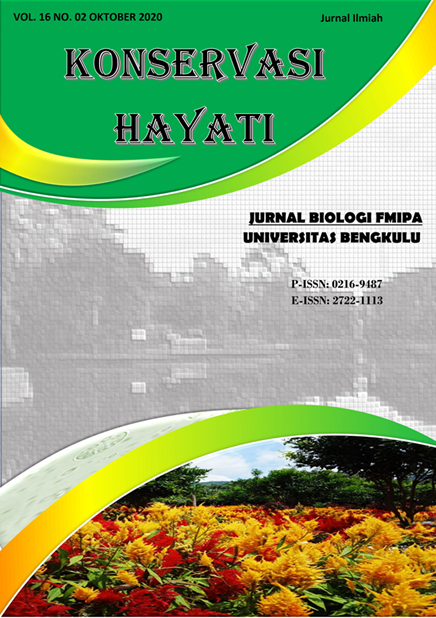Main Article Content
Abstract
Podostroma cf. cornu-damae di Indonesia pertama kali dilaporkan oleh Boedijn pada tahun 1934 di Buitenzorg (Bogor), Jawa Barat. Sejak saat itu, tidak ditemukan adanya laporan kembali mengenai jamur tersebut di Indonesia. Pada tahun 2020, beberapa masyarakat lokal yang tergabung dalam komunitas pemburu jamur Indonesia membagikan informasi mengenai keberadaan jamur tersebut dari hutan Tamiang Layang (Kalimantan Tengah) dan Sukabumi (Jawa Barat). Identifikasi morfologi yang disertai deskripsi dan karakterisasi makroskopis mengkonfirmasi identitas jamur tersebut sebagai Podostroma cf. cornu-damae dan Podostroma sp. Observasi karakter mikroskopis atau pendekatan molekuler perlu dilakukan untuk memastikan hal tersebut pada penelitian selanjutnya. Informasi ini menambah data inventarisasi kekayaan ragam jamur di Indonesia.
Keywords
Article Details
Authors who publish in this journal agree with the following terms:
- Authors retain copyright and grant the journal right of first publication with the work simultaneously licensed under a Creative Commons Attribution-ShareAlike 4.0 International License that allows others to share the work with an acknowledgement of the work's authorship and initial publication in this journal.
- Authors are able to enter into separate, additional contractual arrangements for the non-exclusive distribution of the journal's published version of the work (e.g., post it to an institutional repository or publish it in a book), with an acknowledgement of its initial publication in this journal.
- Authors are permitted and encouraged to post their work online (e.g., in institutional repositories or on their website) prior to and during the submission process, as it can lead to productive exchanges, as well as earlier and greater citation of published work (See The Effect of Open Access).
- This work is licensed under a Creative Commons Attribution-ShareAlike 4.0 International License.
References
- Arora, D. 1986. Mushrooms Demystified. USA, Teen Speed Press.
- Chamberlain, H. L., Rossman, A. Y., Stewart, E. L., & Samuels, G. J. 2004. The stipitate species of Hypocrea (Hypocreales, Hypocreaceae) including Podostroma. Karstenia, 44(1-2), 1–24. http://dx.doi.org/10.29203/ka.2004.39.
- Choe, S., In, S., Jeon, Y., Choi, H., & Kim, S. 2018. Identification of trichothecene-type mycotoxins in toxic mushroom Podostroma cornu-damae and biological specimens from a fatal case by LC–QTOF/MS. Forensic Science International, 291, 234-244. http://dx.doi.org/10.1016/j.forsciint.2018.08.043.
- Gonmori, K., Fujita, H., Yokoyama, K., Watanabe, K., & Suzuki, O. 2011. Mushroom toxins: a forensic toxicological review. Forensic Toxicology, 29(2), 85-94. http://dx.doi.org/10.1007/s11419-011-0115-4.
- Graeme, K. A. 2014. Mycetism: A Review of the Recent Literature. Journal of Medical Toxicology, 10(2), 173-189. http://dx.doi.org/10.1007/s13181-013-0355-2.
- Largent ,D.L. 1977. How to Identify Mushrooms to Genus I: Macroscopic Features. Eureka (CA), Mad River Press Inc.
- Lee, S. R., Seok, S., Ryoo, R., Choi, S. U., & Kim, K. H. 2018. Macrocyclic Trichothecene Mycotoxins from a Deadly Poisonous Mushroom, Podostroma cornu-damae. Journal of Natural Products, 82(1), 122-128. http://dx.doi.org/10.1021/acs.jnatprod.8b00823.
- Putra IP, Sitompul R, Chalisya N. 2018. Ragam Dan Potensi Jamur Makro Asal Taman Wisata Mekarsari Jawa Barat.Al-Kauniyah: Jurnal Biologi, 11(2):133–150. http://dx.doi.org/10.15408/kauniyah.v11i2.6729
- Putra, IP & Hafazallah, K. 2020. Catatan Komunitas Pemburu Jamur Indonesia : Kolaborasi Lintas Profesi dan Generasi Mengenai Etnomikologi Jamur-Jamur Indonesia. Sukabumi : Haura Publishing.
- Rokuya, I., Yoshio, O., Tsugia, H. 2011. Fungi of Japan. Japan, Yama-Kei Publishers.
References
Arora, D. 1986. Mushrooms Demystified. USA, Teen Speed Press.
Chamberlain, H. L., Rossman, A. Y., Stewart, E. L., & Samuels, G. J. 2004. The stipitate species of Hypocrea (Hypocreales, Hypocreaceae) including Podostroma. Karstenia, 44(1-2), 1–24. http://dx.doi.org/10.29203/ka.2004.39.
Choe, S., In, S., Jeon, Y., Choi, H., & Kim, S. 2018. Identification of trichothecene-type mycotoxins in toxic mushroom Podostroma cornu-damae and biological specimens from a fatal case by LC–QTOF/MS. Forensic Science International, 291, 234-244. http://dx.doi.org/10.1016/j.forsciint.2018.08.043.
Gonmori, K., Fujita, H., Yokoyama, K., Watanabe, K., & Suzuki, O. 2011. Mushroom toxins: a forensic toxicological review. Forensic Toxicology, 29(2), 85-94. http://dx.doi.org/10.1007/s11419-011-0115-4.
Graeme, K. A. 2014. Mycetism: A Review of the Recent Literature. Journal of Medical Toxicology, 10(2), 173-189. http://dx.doi.org/10.1007/s13181-013-0355-2.
Largent ,D.L. 1977. How to Identify Mushrooms to Genus I: Macroscopic Features. Eureka (CA), Mad River Press Inc.
Lee, S. R., Seok, S., Ryoo, R., Choi, S. U., & Kim, K. H. 2018. Macrocyclic Trichothecene Mycotoxins from a Deadly Poisonous Mushroom, Podostroma cornu-damae. Journal of Natural Products, 82(1), 122-128. http://dx.doi.org/10.1021/acs.jnatprod.8b00823.
Putra IP, Sitompul R, Chalisya N. 2018. Ragam Dan Potensi Jamur Makro Asal Taman Wisata Mekarsari Jawa Barat.Al-Kauniyah: Jurnal Biologi, 11(2):133–150. http://dx.doi.org/10.15408/kauniyah.v11i2.6729
Putra, IP & Hafazallah, K. 2020. Catatan Komunitas Pemburu Jamur Indonesia : Kolaborasi Lintas Profesi dan Generasi Mengenai Etnomikologi Jamur-Jamur Indonesia. Sukabumi : Haura Publishing.
Rokuya, I., Yoshio, O., Tsugia, H. 2011. Fungi of Japan. Japan, Yama-Kei Publishers.
